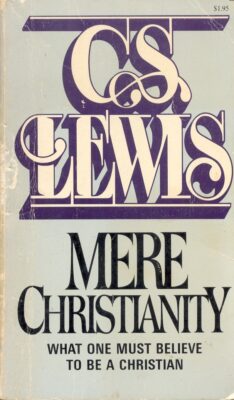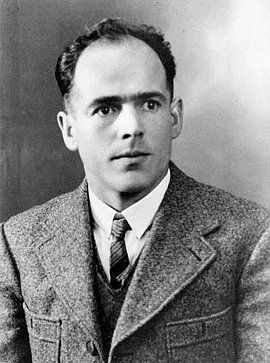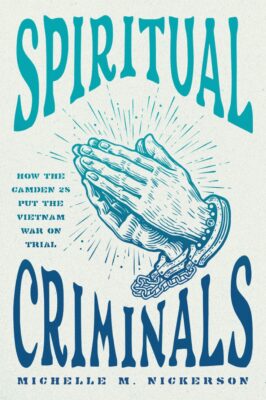Editor's Note
Post #10 in an ongoing series related to Michelle Nickerson’s Spiritual Criminals. This is the final entry.
Michelle Nickerson’s Spiritual Criminals demonstrates the ongoing relevance of many of the book’s topics to contemporary Catholicism. Some of the following have been added or highlighted by me, but they include: white privilege, church-state relations, Catholic Social Teachings, gender troubles (feminism, masculinity), pro-life politics, abortion, patriotism, individual conscience, the acceptable limits of public activism/protest, and more.
The last one I want to propose for you is the orthodox-unorthodox dialectic in Catholicism. What are the questions, answers, and contradictions around both themes for Catholics? How are orthodox-unorthodox problems transcended? Which theses and antitheses remain in place? How does this all matter in relation to Camden-28 actors? I can’t answer all of these questions fully, but I think Nickerson’s story suggests some contours around orthodoxy-unorthodoxy issues.
 I confess a strong personal interest in the orthodox-unorthodox dialectic. When I became an active Christian in college, I fell into an intellectual crowd that concerned itself with lower-case orthodoxy. Granted, their concern (and mine) existed, at that time, in the context of Protestantism. It was an interest that flowed out of a shared reading of C.S. Lewis’s Mere Christianity. While I do not recall Lewis explicitly talking about lower-case ‘orthodoxy’ as a Christian ideal (checked: he does mention “Greek Orthodoxy” at one point in the text’s Preface), it is no major logical jump to go from “mere” to orthodoxy.
I confess a strong personal interest in the orthodox-unorthodox dialectic. When I became an active Christian in college, I fell into an intellectual crowd that concerned itself with lower-case orthodoxy. Granted, their concern (and mine) existed, at that time, in the context of Protestantism. It was an interest that flowed out of a shared reading of C.S. Lewis’s Mere Christianity. While I do not recall Lewis explicitly talking about lower-case ‘orthodoxy’ as a Christian ideal (checked: he does mention “Greek Orthodoxy” at one point in the text’s Preface), it is no major logical jump to go from “mere” to orthodoxy.
As a newly active Christian, I sought to attach myself to something with broad appeal that would undermine conflicts and factionalism. I did not want my own Christianity to maximally alienate me from friends and family. I had grown up with Latter Day Saints on one side of my family. The other side were sort of ‘cultural Christians’—but they also regularly undermined Christian claims by simplistically citing faith issues as “the cause of all wars.” The consequence of this tension my parents avoiding their kids to any church. Their inactivity in that realm was undermined, however, by my participation in the Boy Scouts of America (now known as “Scouting America”). Scouting encouraged growth in a faith, any faith, and I chose to minimally explore (and passively profess) Christianity for the sake of having a default answer when questioned by my Scout leaders. That ‘default answer’ become a reality in college, and with it a desire to profess something palatable to a wide range of people. Orthodoxy helped me somewhat (ironically) in that regard.
My enthusiasm for ‘mere’ Christianity or orthodoxy, however, enabled a disdain for anything that smacked of ‘liberalism’ in the faith. You can probably see where this was headed for me politically (i.e., conservatism). You can see also why I think the orthodox-unorthodox dialectic matters in Nickerson’s story. If a certain cohort of present-day readers feel that the Camden-28 and other draft board raiders were just unorthodox Catholics—or worse, lefties and liberals—why bother attending to that history?
In the text of Spiritual Criminals, the orthodox-unorthodox appears indirectly in Nickerson’s discussion of traditional values in relation to, or in tension with, social progress and Catholic social teachings. As Nickerson notes: “For much of its long life, the Vatican had sought to insulate Catholics from transformational forces like science, technology, and capitalism as protection against possible corruption of the soul” (p. 12). This meant, for feminists, that “church authorities…regarded developments like the women’s movement and sexual liberation warily, as dangerous threats to traditional values” (p. 13). Catholicism believed freedom to be in tension with tradition, even while teaching that Jesus helped to liberate the poor and downtrodden from the yoke of the rich or law-bound Pharisees.
How could modern mass America coexist with the Catholic ideal of a society of households? What does modernity and its liberalizing ethos do to religions that focus on a “centrality of and reverence for family life” (p. 55)? What if making peace with repressive forces involved a separation from family? What if one’s belief in the liberation of women caused a break with the masculine forces that infected Church hierarchy? What if the church’s teachings about community seemed to reinforce calls for more liberal community structures? Nickerson touches on these topics in her set up for chapter three, appropriately titled “One Big Catholic Movement Family” (pp. 55-74).
I appreciated Nickerson’s story of this moment in the history of the U.S. Catholic Left because of its attempt at orthodox-unorthodox permeability. She speaks to the Catholic Left “self-consciously adopt[ing] the church’s communitarian traditions even as they challenged and pushed against its boundaries” (p. 57). In the context of community, the Catholic Left “sought to create a theological opportunity for prophetic intervention, for the Holy Spirit to move through its non-conformers as another means of realizing justice goals” (p. 57).
And now we are to the crux of things: prophecy. Traditionalists and so-called orthodox Catholics have the most trouble integrating prophecy into their theological perspective. Prophecy is, I believe, the synthesis between the orthodox-unorthodox/thesis-antithesis dialectic. The ‘orthodox’, however, incorporate prophets only when they are either deep in history or when they have already made them outcasts—after having hazed, reviled, and rejected them. Prophets are admitted into tradition only after their words, whether predictions, corrections, or jeremiads, are proven. How are they proven? Only after time and experience have vetted them.
This problem is well-documented, even in Catholicism’s sacred texts and traditions. Of course the Christian Bible itself inveighs many times against “false prophets” (New Revised Standard Version). Even so, it also warns, from Jesus himself, that “a prophet has no honor in the prophet’s own country” (John 4:44). Jesus lamented for “Jerusalem, the city that kills the prophets and stones those who are sent to it!” (Matthew, 23:37). The stories of Old Testament prophets are littered with rejection (Moses, Samuel, Elijah, Jeremiah, Isaiah). Many writings, moreover, of Catholicism’s most prominent thinkers (and especially scientists) have been condemned or “indexed” (restricted) before they are released (e.g., Descartes, Galileo). If I am recalling this correctly, Aquinas’ writings were restricted for years before they became accepted. At a minimum Aquinas was denounced for some years after his works were first published (see “Condemnation of 1277”).[1]
Traditionalists and the orthodox most often condemn novelty. They revile those who, in the present, proclaim (in an unsanctioned fashion) to speak for, or even in the spirit of, God. The ‘unsanctioned’ are those without credentials, or who have not been selected as priests or preachers. Traditionalists demand that only approved members of the community can interpret tradition. Most often, moreover, those interpreters are selected by traditionalists who disapprove of novelty, originality, and innovation. Freshness, nonconformity, and relevance are necessarily shunted aside. Prophets, and hence prophecy, are weeded out. Conformism is the order of the day.

Franz Jägerstätter, 1907-1943 (undated)
Nickerson illustrates this in the case of the Austrian martyr Franz Jägerstätter. Here is how the martyr is introduced as “the ultimate Catholic noncomformist” of the midcentury:
The deeply religious peasant refused to fight on behalf of the Axis powers. He was, in most respects, the model parish family man, who joyously but quietly observed the rituals of country life in the alpine Catholic world of mid-twentieth-century Austria. After the Anschluss forced him into military training, Jägerstätter decided his conscience, formed by the church’s teachings, would not allow him to serve the Reich. With the tacit approval of Austria’s cardinals and bishops, the Germans executed him by guillotine (p. 57)
Nickerson expands by noting that church officials attempted to censor the story, which of course backfired. A 1965 book about Jägerstätter by Gordon Zahn, titled In Solitary Witness, galvanized the Catholic Left. Nickerson notes that it “contributed to the zeal of prophetic witness” in the mid-1960s (p. 57). It also drove a wedge between the patriotic American church fostered by Cardinal Spellman.
It is important to note that ‘prophetic’ in this context meant something more immediate and less fantastical than ‘foresight’. It is not about seeing the literal future in the manner of a seer. Rather, prophecy, in the sense conveyed by Zahn about Jägerstätter, meant something like ‘extraordinary’ or ‘supernatural’ insight. It is about observing something crucial that no one else sees in a situation or issue. It can also be about being ahead of one’s times. This kind of sensibility about prophecy is beyond the common usage of the term in English. The plain meaning for many is simply about seeing the future. These insightful prophetic observations are very often unwelcome; they create discomfort or even violent reactions. Conservatives almost always reject these kinds of prophecy.
Nickerson’s 1960s Catholic Leftists were inspired by Zahn and Jägerstätter to be prophetic in relation to peacemaking. Their consciences demanded direct, dramatic, and unorthodox resistance action. They were inspired to go way beyond just speaking out—to do something meaningful, at least with themselves. For instance, Gordon Zahn himself, then a professor at Loyola University Chicago for fourteen years, felt unwelcome at his institution for his work. He left to take a position in Massachusetts. He would go on to participate in the Milwaukee draft board raid in September of 1968. That action involved fourteen total raiders who destroyed, with homemade napalm, approximately 10,000 records (p. 57).[2]
Another unorthodox actor in Spiritual Criminals was outlined in a prior post: the priest and Camden 28 member, Michael Doyle. Doyle had “used ashes on Ash Wednesday made ‘by burning the Pentagon Papers’ instead of the traditional ones made from palm leaves.” He had “invited participants to see fully ‘the death they symbolize and take upon ourselves the burden of guilt’ that these ashes represent” (pp. 134-136).
The term ‘orthodox’ arises in the text in relation to another person associated with, but not involved in, the Camden-28 action: Mary Schmelzer. Schmelzer was a college graduate, as well as married and with two children. Whether due to those factors or a less forward personality, she desired “to be part of [the] Catholic Resistance but did not want to assume the risks associated with [dir

Michelle Nickerson, *Spiritual Criminals: How the Camden 28 Put the Vietnam War on Trial* (University of Chicago Press, 2024)
ect action in] the draft board raids” (p. 139). Nickerson sets up Schmelzer as having been raised in a Catholic family whose Catholicism was “more ritual” and, in Schmelzer’s words, “simple, uncomplicated, [and] unsophisticated.” Despite their habits, they were not “especially strict or orthodox in their devotion” (p. 139). With the institutional church, her family supported the war in Vietnam. Mary’s husband, John Schmelzer, was also a Catholic.
Nickerson relays that the Civil Rights Movement and antiwar actions “radicalized” the couple. Mary Schmelzer began reading works by Thomas Merton, Daniel Berrigan, and Dorothy Day. She also become involved with a group called “Clergy and Laity Concerned about Vietnam.” Through classes she taught at the Philadelphia College of Textiles and Science, Mary met a Camden-28 member, Cookie Ridolfi (introduced in this post). Mary and Cookie became lifelong friends. Mary would assist the “Camden 28 Defense Committee” after the action members, including Cookie, were arrested (pp. 139-140).
Mary’s journey from ritual-habitual traditional Catholicism to a nonconformist, activist position at odds with the institutional church (and her family) is exemplary of many Camden-28 action members. The state of things in the U.S. felt wrong to them. The struggles of the Civil Rights and antiwar movements exemplified disconnects with the ideals of the church, evident in its social teachings. The overall hypocrisy, bigotry, deception, and lies related to war and racism fostered a move toward unorthodoxy. The times demanded prophetic action—an expansion of the possible in relation to church teachings.
The Catholic Left and Catholic Radicals were, then, unorthodox by necessity. Per the gospel of Mark, they knew that new wine demanded new wineskins. Pushing social, theological, familial, ethical, and legal boundaries caused, of course, reactions. The unorthodoxy of the Camden-28 had many negative social consequences, despite their eventual legal acquittal. Some have lived with the consequences of their ‘spiritual criminality’ for the rest of their lives. Nickerson does not find many regrets, however, by Camden-28 members in her study. Their consciences would have it no other way. Prophetic action was the synthesis that arose from the orthodox-unorthodox dialectic in 1960s Catholicism.
——————————————–
Notes
[1] The Condemnation[s] of 1277, issued by Bishop of Paris, Stephen Tempier, hit Aquinas both indirectly and directly. See sub-section #6 at the Stanford Encyclopedia of Philosophy at this link (accessed 1/11/2025).
[2] For more on some of the other Milwaukee 14 activists, see also Dennis Sadowski, “After 50 years, draft board protesters insist what they did was right,” National Catholic Reporter, Sept. 1, 2018, available at this link, accessed Jan. 8, 2025.

0